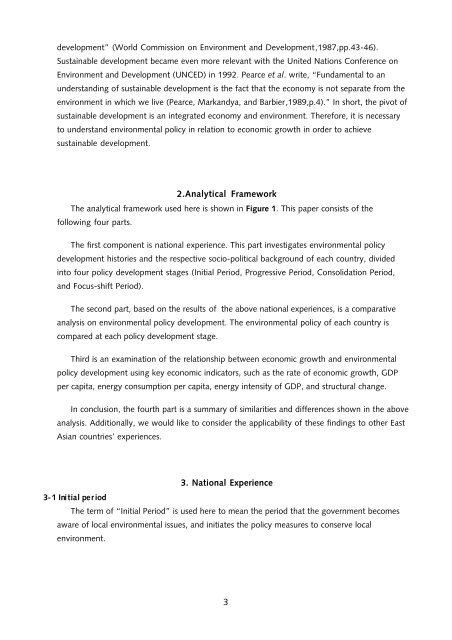Untitled - UNU-IAS
Untitled - UNU-IAS
Untitled - UNU-IAS
You also want an ePaper? Increase the reach of your titles
YUMPU automatically turns print PDFs into web optimized ePapers that Google loves.
development” (World Commission on Environment and Development,1987,pp.43-46).<br />
Sustainable development became even more relevant with the United Nations Conference on<br />
Environment and Development (UNCED) in 1992. Pearce et al. write, “Fundamental to an<br />
understanding of sustainable development is the fact that the economy is not separate from the<br />
environment in which we live (Pearce, Markandya, and Barbier,1989,p.4).” In short, the pivot of<br />
sustainable development is an integrated economy and environment. Therefore, it is necessary<br />
to understand environmental policy in relation to economic growth in order to achieve<br />
sustainable development.<br />
2.Analytical Framework<br />
The analytical framework used here is shown in Figure 1. This paper consists of the<br />
following four parts.<br />
The first component is national experience. This part investigates environmental policy<br />
development histories and the respective socio-political background of each country, divided<br />
into four policy development stages (Initial Period, Progressive Period, Consolidation Period,<br />
and Focus-shift Period).<br />
The second part, based on the results of the above national experiences, is a comparative<br />
analysis on environmental policy development. The environmental policy of each country is<br />
compared at each policy development stage.<br />
Third is an examination of the relationship between economic growth and environmental<br />
policy development using key economic indicators, such as the rate of economic growth, GDP<br />
per capita, energy consumption per capita, energy intensity of GDP, and structural change.<br />
In conclusion, the fourth part is a summary of similarities and differences shown in the above<br />
analysis. Additionally, we would like to consider the applicability of these findings to other East<br />
Asian countries’ experiences.<br />
3. National Experience<br />
3-1 Ini tial period<br />
The term of “Initial Period” is used here to mean the period that the government becomes<br />
aware of local environmental issues, and initiates the policy measures to conserve local<br />
environment.<br />
3

















